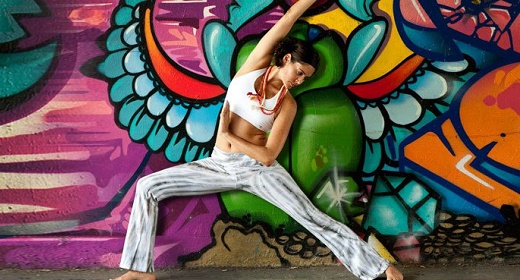by Kara-Leah Grant: How to Commit to a daily Yoga practice…

There are many people doing yoga poses today, but there are far less people who have a yoga practice.
Postures are everywhere – Instagram, Facebook, Twitter, Pinterest, advertising, magazines, yoga classes, yoga retreats, yoga teacher trainings.
However, postures do not make a yoga practice.
Posture Vs Practice
A yoga practice requires at least two other important elements before it can serve it’s purpose – that of self-realisation, or of waking the practitioner up from the dream of Maya (illusion).
Of course, not everybody is doing postures for the purpose of self-realisation. Many people are doing postures to get things, like flexibility, strength, injury recovery, a yoga high, popularity, sponsorships, a sexy partner or even fame.
There is irony there when that which serves to lesson our ego identification – yoga postures – has instead become something which now enforces a new, stronger ego identification. That of Yogi.
Not in the old sense of the word as one who is self-realised (or well along the path), but as in “one who does yoga postures”.
But without two crucial elements accompanying the practicing of postures, one will never develop a yoga practice, nor break the binds of identification that create Maya and prevent self-realisation.
Crucial Elements
The first is a container. And the second is a teacher. Both of these two elements need to be present, because without a container, the teacher is ineffectual, and without a teacher, a container is impossible.
Why are these two elements of container and teacher crucial to create a yoga practice?
Because the real work of yoga arises not in the physical achievement of the postures, but in the understanding of the Self through observation of our relationship to the postures.
This is the difference.
You can have the perfect Trikonasana posture and be filled with pride, which is one of the five Kleshas. If you don’t have a container or a teacher, you are unlikely to recognise the truth of your experience, which is one of Maya or illusion. Your experience is clouded by a klesha (thought).
Or, you may have a pathetic, useless Trikonasana posture, yet be in that posture with calm, abiding presence. No attachment, no aversion. It’s unlikely though that you will ever arrive in this place without the container or teacher.
The Power of the Container
So what is a container in relationship to our yoga practice? A container is the form which holds the formless and allows you to fluctuate on a daily basis – as you will – while holding you steady.
A concrete example of a container is a daily home practice. No matter what is happening in your life and no matter how you feel, you turn up to your mat every day for a period of time and do something.
Another example of a strong container is a month-long immersion experience. You don’t have to think about whether or not to show up for yoga as you are already on the immersion.
In both of these cases, the container means that when the going gets tough – as it always does in our yoga practice – we’re far less likely to turn away from our practice and avoid facing whatever is arising and ready to be released.
This is the power of the container. It creates a space and holds us steady so we can do the challenging work of ego dissolution. This is why immersions are such powerful experiences and can accelerate our growth so much.
However, a container can not function without a teacher. It is the teacher that watches us and notices where we are holding on or attached, where we are avoiding or in aversion. It is the teacher that notices how we are relating to the postures and what samskaras (limiting beliefs) are shaping our practice.
On an immersion, it is the teacher we go to when we’ve hit the wall and don’t think we can turn up to class again. It is the teacher who notices our psychological state and provides us with the necessary support and practices to help us through this stage in our awakening.
The Keys to the Greatest Awakenings
This teacher doesn’t have to be external though – it is possible to develop a strong-enough internal teacher and do the hard work of self-realisation by oneself.
This is when the external container becomes even more important. Because when you’re working with an internal teacher, it is easy to fool yourself and come up with all kinds of reasons for not practicing. However, when you’ve committed to a daily home practice, the container will hold you strong.
Because no matter what our commitment to our yoga practice is, it is inevitable that life will happen.
We will get busy, sick, over-whelmed or resistant towards our yoga practice. Without a strong container and awareness of the importance of that container, we will stop practicing our yoga.
Paradoxically, it is these times when we need our practice the most. The days with the strongest mat resistance hold the keys to the greatest awakenings. The times when our lives are busy is when we most need the stillness of our mat. The times when we’re sick is when we most need to be present. The times when we feel over-whelmed is the time when our practice can bring us to centre and strength.
The establishment of a container holds us strong through all these times when we are not strong. It supports us, encourages us, whispers to us, beckons us.
Yet a container can also make us feel trapped and boxed in, tied down and constricted. We rail against the idea of having to do something every single day, we rail against the idea of committing to something greater than ourselves. We rail against the idea of giving up our freedom.
Own It
But this IS the journey of self-realisation. This is what loosens the chains of illusion. This is what dissolves the layers of the false self.
And of course that part of us which is threatened by self-realisation – the ego – will rail against anything which takes us further down the path to enlightenment.
Commitment to daily self-practice is the first step towards self-realisation. One can not turn up to the mat every single day without facing one’s own demons. It is impossible.
 Commitment to daily self-practice is the first step towards self-realisation.
Commitment to daily self-practice is the first step towards self-realisation.Of course, one has to want to face one’s own demons. And many of us don’t, even if wethink we do. We’re too busy distracting ourselves, entertaining ourselves, avoiding ourselves, denying ourselves, and running away from ourselves. While defending our right to do so and thinking we’re practicing yoga when we’re really just practicing postures.
Which is ok too.
If you don’t care about self-realisation and just want to get your pose on, own that. Do your thing, but don’t delude yourself into thinking you’re practicing yoga. You’re not. You’re creating shapes with your body. Own that too. It’s fun right?
The Final Step
If you are ready to step into a yoga practice, create a container for yourself and find yourself a teacher. Or become your own teacher.
Try a Forty Day practice. Get on your mat every day for forty days and do seven minutes of practice. That’s enough. It’s not the postures that are important here – it’s the container. Creating it, maintaining it and honouring it. Through the practice of containership, the yoga will come.
As you become more proficient at creating and maintaining containers, go for a stronger version. Choose a specific practice that you must do every day as well. Nail that, and then add another layer. Make that specific daily practice happen at a specific time.
Observe yourself in relationship to that container, because this observation of Self is the yoga. What does your mind do? What thoughts come up? What feelings? Are you attached? Are you in aversion?
Or, find a great external teacher you can work with consistently and commit to your practice with them. Go on an immersion with them. Do a retreat. Show up to their classes every single week and ask them questions after class about your practice. Then take what they’ve told you and apply it.
Now you have a yoga practice.













































